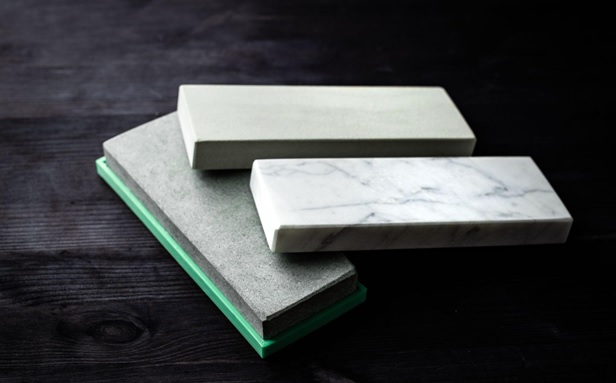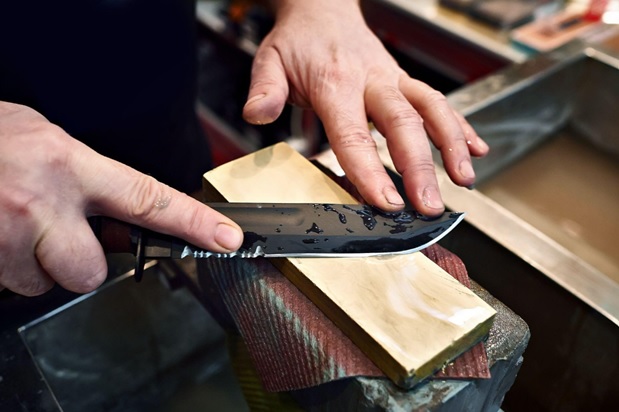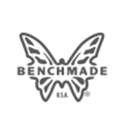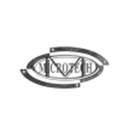Your Folding Utility Knife and Pocket Knife Sharpeners: How to Get a Razor’s Edge
12th Aug 2024
Being able to use a sharpening stone to bring your folding utility knife back to like-new performance is a skill that isn’t just nice to have - it’s essential.
The fact of the matter is that knowing how to properly sharpen the knife you carry is every bit as important as knowing how to clean it, how to prevent corrosion, and how to handle it safely.
With that said, this short guide will break down the basics of pocket knife sharpeners and how to use them to bring a butter knife-dull folding utility knife back to its former glory.
So let’s unpack the layers.
Where to Start with Pocket Knife Sharpeners: What Types Are There?
There are all different sorts of knife sharpening kits and pocket knife sharpeners. How you will use these will be determined largely but what your familiarity is with each, as well as what type of blade you have.
First, we need to talk about a specifier known as grit. Grit tells you how coarse the stone is. The higher the number, the finer the grit; the lower, the coarser.
If you have a very dull knife, you will need to use a low grit (coarse) pocket knife sharpener to re-profile the edge or restore the bevel. Low grit stones are used for steel stock removal, for this purpose.
Then you have mid-grit sharpening stones, say, between 600 and 1000 grit, which are used to put a decent edge on a knife or tool.
On the other end, you have high grit (fine) stones, above 1000 grit. Between 1000 grit and 3000 grit is fine enough to put a shaving-sharp edge on a knife or tool. Higher than 3000 grit is generally reserved for razor blades.
In addition to knowing how grit works, you’ll also want to know what sorts of pocket knife sharpeners there are, as there are several different types.
One easy-to-use type of pocket knife sharpener is a pull through sharpener. These have carbide or ceramic rods set in a “V” configuration. To use, you simply press the edge of the knife into the slot and pull the knife backwards through it.
They are easy to use, require basically no skill, and can be used to put a decent edge on a knife. They are not without drawbacks, though. For one, you can’t change the sharpening angle, so you can’t customize the edge, and you also can’t put a very fine edge on a tool with one. In general, they are also not good for restoring very dull blades.
There are also sharpening rods. These are usually made of ceramic. To use, you draw the edge of the knife along the rod at an angle to restore it. While rods are generally not as easy to use as sharpening stones, they do have some advantages. One is that fine rods can be used to sharpen serrated knives. The other is that you can’t sharpen inwardly curved knives, like hawkbill knives and karambits, on a stone. To sharpen them, you need a rod.
Then you have pocket knife sharpening kits, some of which use belts or a series of stones that are guided, helping you to put an edge on the knife. By following the included instructions with one of these kits, you can restore your knife’s edge. Some of them are a little confusing to learn how to use, but others are very straightforward and can be used to get a very fine edge back on your knife.
Then we have basic knife sharpening stones. There are two broad types: pocket stones, which are small enough to fit in a pocket (hence the name) and bench stones, which are larger and designed to be mounted to a bench. Some are even pre-mounted to a piece of wood, or to a rubber base, just for that purpose.
There are also synthetic stones and natural stones. Many natural stones are made from novaculite, often marketed as Arkansas stone. There are soft, hard, and hard black Arkansas stones (as well as a few other grades) which increase in fineness of grit from soft to hard. That is, a soft stone is a lower grit than a hard or hard black stone. Grit ratings are only estimations in natural stone, though, as no two natural stones are exactly alike.
Stones in a series of grits can be used to re-profile a knife’s edge, as well as to put a very fine, shaving sharp edge on one.

Getting a Razor’s Edge on Your Folding Utility Knife Using a Sharpening Stone
Let’s say your folding utility knife has a very dull edge, dull enough that it’s not much better than a butter knife. This is how to get a good edge back on it.
First, start with a bench sharpening stone in a very low grit - somewhere around 100 grit, perhaps as high as 220 grit, depending on how dull the knife is.
For most general applications, you can use somewhere around 20° for a folding utility knife. Lay the blade flat on the stone and lift the spine till it is about a centimeter off the stone. That will give you an angle in the ballpark that you’re going for.
Pass the edge over the stone as though you are attempting to shave a thin layer off of it. That will take some of the steel off of the edge, helping you to re-profile it. Do this a set number of times, say 20 or 30, then flip the knife over and repeat on the other side.
When you’re done with the first set of passes on the coarse stone, check the edge carefully with your thumb. If it is still dull, keep going. If it is starting to regain an edge or you can feel a raised, slightly sharp burr, proceed to the next grit.
From here you can progress towards a 400 or 800 grit stone. Repeating the process. Remember to mirror the number of passes you make on each side of the blade and to use the same angle, so as to produce a consistent, even edge.
After you get through the intermediate step, move onto a stone in a higher grit, around 1000. Continue the process until you have a sharp edge. If you want a really sharp edge, continue to the next highest grit - somewhere around 3000 grit. If you’re using natural stones, you’ll be at a hard black Arkansas stone by this point.
The final step in getting a razor sharp edge on your folding utility knife, after you’ve finished with the highest grit stone, is to strop it.
For this, you can use a leather strop, or your belt, or your pant leg, or even a piece of cardboard. Lay the flat side of the knife flat against the strop material, and then draw the knife in the direction of the spine, away from the edge.
This process aligns the microserrations of the blade’s edge, resulting in a much finer, sharper structure. Done properly, you will produce an edge that is sharp enough to shave with, or nearly so.

Your Next Pocket Knife Sharpening Stone is Here
Sharpening your knives, and refining the edge, can be done with a basic sharpening stone or a professional knife sharpener. The most important thing is that you know the essentials, and know how to do it.
We carry natural stones, synthetic stones, diamond stones, and knife sharpening kits that you can use to make everything from woodworking tools to pocket knives to camp knives sharp again. Take a look through our collection and if you have any questions about anything we sell, be sure to get in touch with us at WhiteMountainKnives@gmail.com and we would be happy to help.









